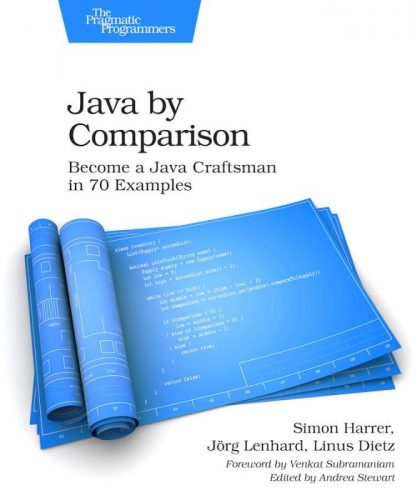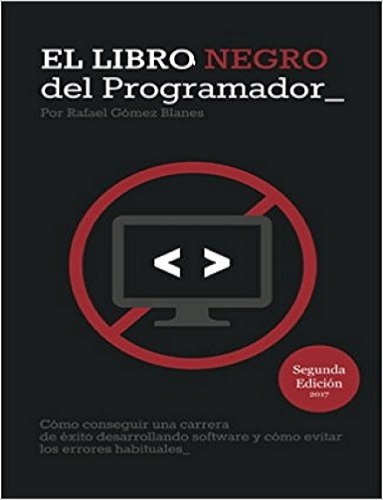This time I will comment on «Java By Comparison: Become a Java Craftsman in 70 Examples», a book aimed at the reader to improve his skills as a Java 8 developer. This is the first book that I read from the publisher, «The Pragmatic Bookshelf», which specializes in books focused on the knowledge and improvement of the different areas of software development. This book has helped me to review those refactoring techniques that I already knew, and to learn others that I didn’t know. To establish a comparison, we could say that this title is a much shorter and lighter version of the famous book «Clean Code».
The book consists of seventy examples grouped into nine chapters in which, first, a code fragment is shown that presents one or more elements that can be improved, and then a second fragment is shown that is refactored with the proposed solution. This format allows you to compare at a glance, the changes and improvements applied to the code by the authors.
Some of the areas that the book focuses on are exclusive to Java version 8, such as the use of the «Optional» object to avoid Null Pointer type exceptions or the optimization of the code through the use of Lambdas expressions. Other chapters, however, are applicable to previous versions of the language, and even to other languages, such as those dedicated to the correct naming of methods and variables, the handling of exceptions, the design of objects, or the improvement of unit tests, among many other examples up to seventy. The last chapter breaks this trend to present, in a more theoretical way, the concepts and tools used in modern software development, such as static code analysis tools or continuous integration.
In short, it is a book that, although it may be a little basic for an experienced developer, is well written and its explanations are clear and concise. It is a recommended book to consolidate or, depending on the reader’s previous knowledge, to acquire new skills in Java code refactoring.
Title: Java By Comparison: Become a Java Craftsman in 70 Examples
Authors: Simon Harrer, Jörg Lenhard, Linus Dietz
Editor: The Pragmatic Bookshelf
Year: 2018
Language: English
Pages: 302
En esta ocasión voy a comentar «Java By Comparison: Become a Java Craftsman in 70 Examples», un libro destinado a que el lector mejore sus habilidades como desarrollador de Java 8. Este es el primer libro que leo de la editorial, «The Pragmatic Bookshelf», especializada en libros enfocados en el conocimiento y perfeccionamiento de las distintas áreas del desarrollo de software. A mí particularmente, esta obra me ha servido para repasar aquellas técnicas de refactorización que ya conocía, y para aprender otras que desconocía. Por establecer una comparación, podríamos decir que este título es una versión mucho más breve y ligera del famoso libro «Clean Code».
El libro consta de setenta ejemplos agrupados en nueve capítulos en los que, primero se muestra un fragmento de código que presenta uno o varios elementos factibles de ser mejorados, para a continuación mostrar un segundo fragmento refactorizado con la solución propuesta. Este formato permite comparar de un vistazo, los cambios y mejoras aplicadas al código por los autores.
Algunas de las áreas en las que se centra el libro son exclusivas de la versión 8 de Java como el uso del objeto «Optional» para evitar excepciones de tipo Null Pointer o la optimización del código mediante el uso de expresiones Lambdas. Otros capítulos, en cambio, son aplicables a versiones anteriores del lenguaje, e incluso a otros lenguajes, como pueden ser los dedicados al correcto nombrado de métodos y variables, el manejo de excepciones, el diseño de objetos, o a la mejora de los test unitarios, entre otros muchos ejemplos hasta sumar setenta. En el último capítulo se rompe esta tónica para presentar, de una manera más teórica, los conceptos y herramientas que se usan en el desarrollo de software moderno, como pueden ser las herramientas de análisis de código estático o la integración continua.
En definitiva, es un libro que, aun pudiendo tener un nivel un poco básico para un desarrollador experimentado, está bien escrito y sus explicaciones son claras y concisas. Es un libro recomendable para afianzar o, dependiendo de los conocimientos previos del lector, adquirir nuevas habilidades en la refactorización de código Java.
Título: Java By Comparison: Become a Java Craftsman in 70 Examples
Autores: Simon Harrer, Jörg Lenhard, Linus Dietz
Editor: The Pragmatic Bookshelf
Año: 2018
Idioma: Inglés
Páginas: 302


